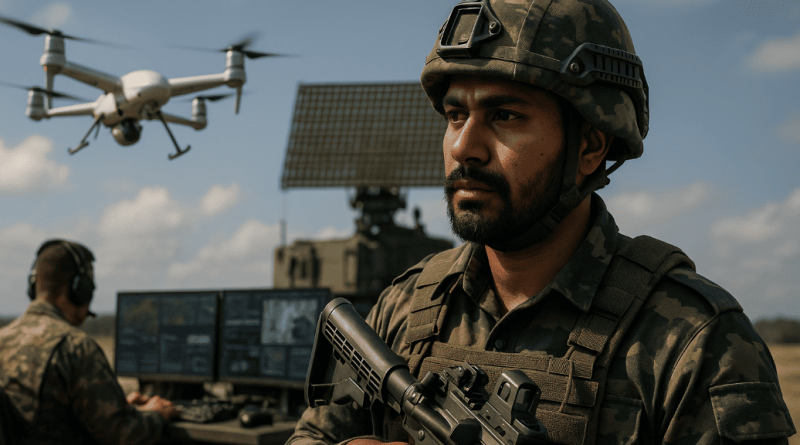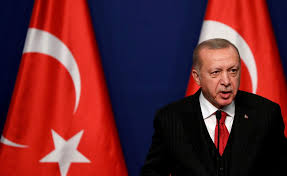AI, Drones, and Cyber: India’s New Military Edge
Buying drones is one thing; making them think and fight responsibly is another. Here lies India’s big bet: artificial intelligence in command and control.
For decades, India’s defence story was often told in terms of tanks, ships, and fighter jets. Today, the narrative is changing. Software is becoming as important as steel, and algorithms are shaping strategies as much as aircraft squadrons. From cybersecurity and drones to artificial intelligence (AI), India is quietly reshaping its role in the global military balance—and doing so in a way that blends technology, resilience, and innovation.
“Armed Forces must operate jointly and remain future-ready in today’s ever-evolving multi-domain environment where cyber, space & information warfare are as potent as conventional operations,” Defence Minister Rajnath Singh said earlier this year. His remark captures a profound shift: wars are no longer just fought with firepower but also with code, data, and machines that think.
Cybersecurity: Protecting the Digital Nervous System
Modern wars begin not with missiles, but with malware. A hacked power grid, a jammed communications network, or a breached financial system can disable a country before a single shot is fired. India, which has experienced repeated cyberattacks on its critical infrastructure, is now taking cybersecurity as seriously as tanks and submarines.
In 2025, the National Critical Information Infrastructure Protection Centre (NCIIPC) and CERT-In tightened breach-reporting rules, forcing institutions to respond faster. Independent reviews have noted that India’s approach has matured from mere “awareness” to proactive governance, with companies adopting global security frameworks like NIST and ISO.
This progress is visible outside the military as well. Recently, MahaMetro signed an agreement with IIT-Kanpur’s C3iHub to secure metro systems, including signalling and telecom networks, against cyber intrusions. Civilian infrastructure is often the first target in hybrid warfare, so hardening it is a form of national defence.
Challenges remain: India still lacks a single, publicly released National Cybersecurity Strategy, and experts warn that faster “red-team” drills are needed to expose vulnerabilities. Still, the trajectory is promising. In a region where a future conflict could begin with a blackout instead of a barrage, resilience is deterrence.
Drones: From Experiments to Core Doctrine
If cyber is the nervous system, drones are fast becoming the muscle. India’s military has embraced unmanned systems not as temporary stopgaps but as a central element of force design.
At the strategic level, New Delhi approved a $4 billion deal for 31 MQ-9B Sea/SkyGuardian drones from the United States. These long-endurance drones provide surveillance over oceans and precision-strike capabilities, directly plugging into India’s networked warfare plans. Crucially, the deal includes domestic maintenance facilities, ensuring India sustains—not just imports—the capability.
At the tactical level, India is also relying on its own innovators. The Army recently placed emergency orders with ideaForge, a Mumbai-based drone startup, for vertical take-off UAVs. These will support frontline soldiers in high-altitude regions like Ladakh, proving that startups can deliver battlefield solutions at speed.
Then comes the futuristic layer: HAL’s “CATS Warrior” loyal wingman project. This drone, designed to fly alongside manned fighter jets, can extend range, carry sensors, and even absorb enemy fire. A prototype was unveiled at Aero India 2025, with first-flight tests expected soon. If successful, it would push India into the league of nations developing combat drone swarms.
The Indian military is also stress-testing these systems. In October, it will conduct its largest-ever drone and counter-drone exercise, codenamed Cold Start. The drills will simulate swarm attacks, electronic warfare, and countermeasures. When militaries train the way they plan to fight, they reveal their theory of victory—and India’s is increasingly unmanned and algorithm-driven.
AI: Trustworthy Autonomy and Faster Decisions
Buying drones is one thing; making them think and fight responsibly is another. Here lies India’s big bet: artificial intelligence in command and control.
The Defence Research and Development Organisation (DRDO) recently launched an “ETAI” framework for ethical and trusted AI, emphasising that systems must be resistant to adversarial cyberattacks and transparent in their decision-making. India’s Chief of Defence Staff underscored that while AI is revolutionising warfare, brittle or hackable AI would be unacceptable in battle.
To institutionalise this, the government has created the Defence AI Council (DAIC) and a dedicated Defence AI Project Agency, ensuring adoption is not piecemeal but structured. Meanwhile, India’s innovation ecosystem is feeding the pipeline. Through the iDEX (Innovations for Defence Excellence) programme, over 40 startup-led technologies have already been inducted into the services—ranging from swarm drones to AI-based surveillance platforms.
The Army’s AI roadmap envisions machine learning crunching battlefield data to cut decision-making time from hours to minutes. The logic is clear: let algorithms sift through the fog of war, but keep humans in charge of the final ethical and legal choices.
Shifting the Global Balance
Why does all this matter internationally? Because military deterrence in the 2030s will not be measured only by the number of fighter jets or tanks a country owns, but by the resilience and adaptability of its systems. The real test will lie in networks that cannot be shut down, sensors that prevent surprise, drones that are cheap enough to be expendable yet effective enough to wear down the enemy, and AI systems that can make faster and more accurate decisions while keeping humans firmly in control.
India is quietly building these advantages. Its cyber defences are becoming more sophisticated, its drone fleets are expanding across different branches of the armed forces, and its AI doctrine is increasingly shaping procurement decisions. Earlier this year, New Delhi even declared 2025 as the “Year of Defence Reforms,” with a clear emphasis on artificial intelligence, space, and robotics—signals that innovation is now central to defence planning.
There is also a significant economic dimension. American think tanks have begun urging Washington to co-produce drones and munitions with India, not just to meet Indian requirements but also to bolster U.S. and allied stockpiles. If India can mass-produce such systems, it could fundamentally reshape defence supply chains across the democratic world, challenging China’s long-standing assumption that democracies lack the industrial staying power to sustain a prolonged conflict.
Risks and Opportunities
Of course, momentum is not guaranteed, and India faces several risks that could slow its progress. Long-term consistency is one challenge, as ambitious projects such as stealth combat drones will have to withstand both budgetary pressures and inevitable technical hurdles. Another is cyber coordination, since the country has yet to finalise a single, unified cybersecurity strategy with clearly defined roles for crisis response. A third concern lies in startup sustainability; without sufficient funding and export pathways, many promising innovations may never scale beyond prototypes.
Yet despite these obstacles, the overall direction is unmistakable. When India retired its last MiG-21 fighter jets this month—a Cold War relic that once symbolised its air power—the moment carried symbolic weight. It underscored a transition away from outdated platforms toward a future built on resilient networks, versatile drones, and trusted AI systems.
If the wars of the next decade are determined by whose systems are hardest to hack, whose drones are cheapest and most expendable, and whose algorithms remain reliable under pressure, then India is no longer just a regional participant. It is positioning itself as an active force reshaping Asia’s—and perhaps the world’s—military balance.



